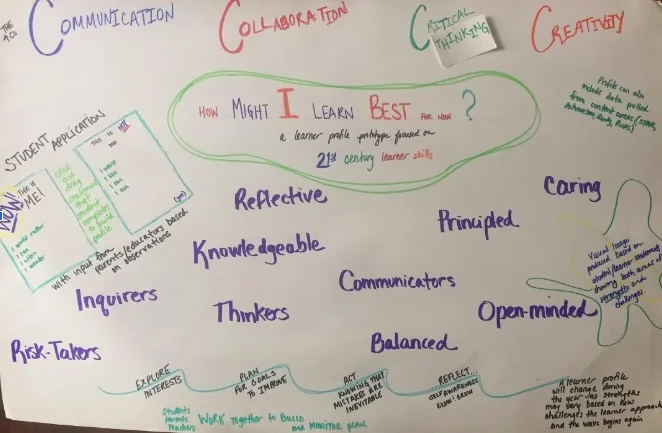Exploring Learner Profiles: Resources, Examples, and Questions to Consider
While next-generation assessments and instructional data can help educators gain a deeper understanding of students, the sheer amount of information available can prove challenging. As I discussed in a prior post, educational technologies can amplify the impact of proven formative assessment strategies. But in doing so, educators must often navigate various platforms and other sources of student information that, in many cases, do not seamlessly align or integrate together.
So how can we make sense of all this information about our students’ abilities and interests?
Enter the concept of “learner profiles.” In general, a learner profile provides a practical way for educators to make use of assessment results, student interest data, and other relevant information. Although they can come in many forms, effective profiles have two main characteristics: they are coherent and actionable. If the information available in the profile is unclear or at times contradictory, it leads to confusion. And if the learner profile does not lead to action regarding changes in instructional practices to further personalize instruction, then a key rationale for the profile is lost.
Many educators and schools that make use of learner profiles are also focusing on including students in their development and revision. Including students throughout the process fosters agency and ownership of the learning since they have a clear say in their strengths, interests, goals, and steps needed to improve certain skills and academic competencies. Several edtech products and platforms are also aiming to simplify the process for teachers so that accessing actionable information in a student’s’ learner profile is as timely and seamless as possible.
Below are key resources, practical examples, and questions to consider when creating learner profiles.
RESOURCES
“If we really believe that teaching is about the student, then it sure would help to actually get to know the students in deeper ways.”
Getting to Know You: Learner Profiles for Personalization (EdWeek)
In this EdWeek article, the author provides specific examples from schools around the country regarding ways that educators are gaining valuable insights about students’ skills, backgrounds, and interests through learner profiles. She also explores how, as opposed to traditional data meetings or interest surveys, learner profiles go a step further as they can foster personalized, student-centered pathways toward student-selected goals.
Learning Profile Grid (ReSchool Colorado)
This tool developed by ReSchool Colorado provides practical resources, strategies, and guidelines to help educators build personalized learning profiles across age spans.
Otus Student Performance / Learning Profile Platform (Video 1, Video 2)
Otus is an example of a new edtech platform that aims to provide teachers with a holistic view of student performance by streamlining student data, teacher feedback, and student learning artifacts from various sources.
Learner Profile for IB Students
CMS Learns (Visual)
Kettering City School District Portrait of a Graduate
Vermont Personalized Learning Plan
Learner Profile Prototype Examples
Below are learner profile prototypes developed by educators at Bristol Warren Regional School District and Propel Schools. Instead of using a ready-made platform for learner profiles, they were tasked with brainstorming what information would be most helpful in that profile and how it could be built leveraging existing tools available in their schools. (Ex. Google Sites, Adobe Spark, Jumprope)
Learner Profile: Middle School Inclusion Class
Jen Crandall (@teachercrandall) (Special Education Teacher at Kickemuit Middle School) Jen
Mary Cabral (@MrsMCabral), ELA Teacher at Kickemuit Middle School
Learner Profile Template - Middle School Example
Mary Cabral (@MrsMCabral), ELA Teacher at Kickemuit Middle School
Learner Profile Survey - High School Example
Liz Johnson, Social Studies Teacher at Mt. Hope High School.
Learner Profiles With FlipGrid
Susan Castigliego, Grade 3 Teacher at Hugh Cole Elementary School
Learner Interest and Goal Inventory
Keith Swist (@keithswist), ELA Teacher at Kickemuit Middle School
Learner Profile Template (Elementary)
Kelly Brum and Renee McDougall, Grade 2 Teachers at Rockwell Elementary School
Kindergarten Learner Profile Template
Kelly Servant (@servantk1), Kindergarten Teacher at Hugh Cole Elementary School
Learner Profile Sketch (Image Above)
Jen Saarinen (@snej80) (Inquiring Minds Teacher at Kickemuit Middle School) Jen’s How Might We Questions Here
Propel Braddock Hills: Student Led Conferences / Learner Profile Sketch (Image Above)
Questions to Consider
When creating and implementing learner profiles, consider the following:
What type of data / learning artifacts are available?
What types of visualizations would be most helpful from the educator viewpoint?
Who would have access to what information?
What role would students have, if any, in the development and use of the profile? Families?
Looking Ahead
Although the concept of Learner Profiles is gaining traction, many schools are still at the early stages of implementing these types of systems and practices. As personalized instructional practices continue to strengthen, and educational technologies enable more seamless data use and integration across platforms, we will see learner profiles emerge as a valuable strategy to include various stakeholders in the learning process and help ensure that all students have the ability to thrive in our schools.




